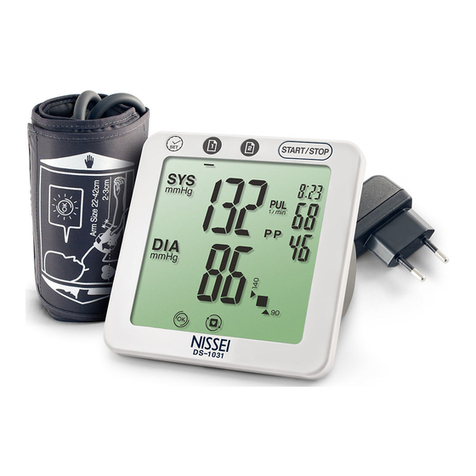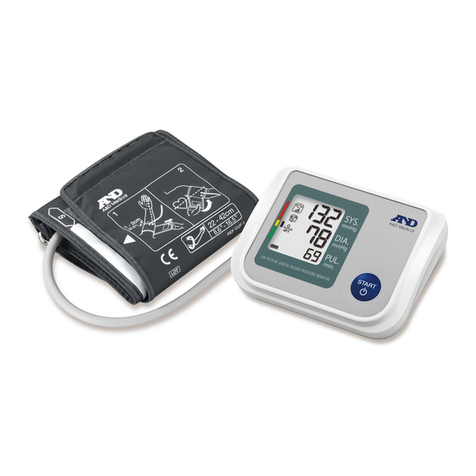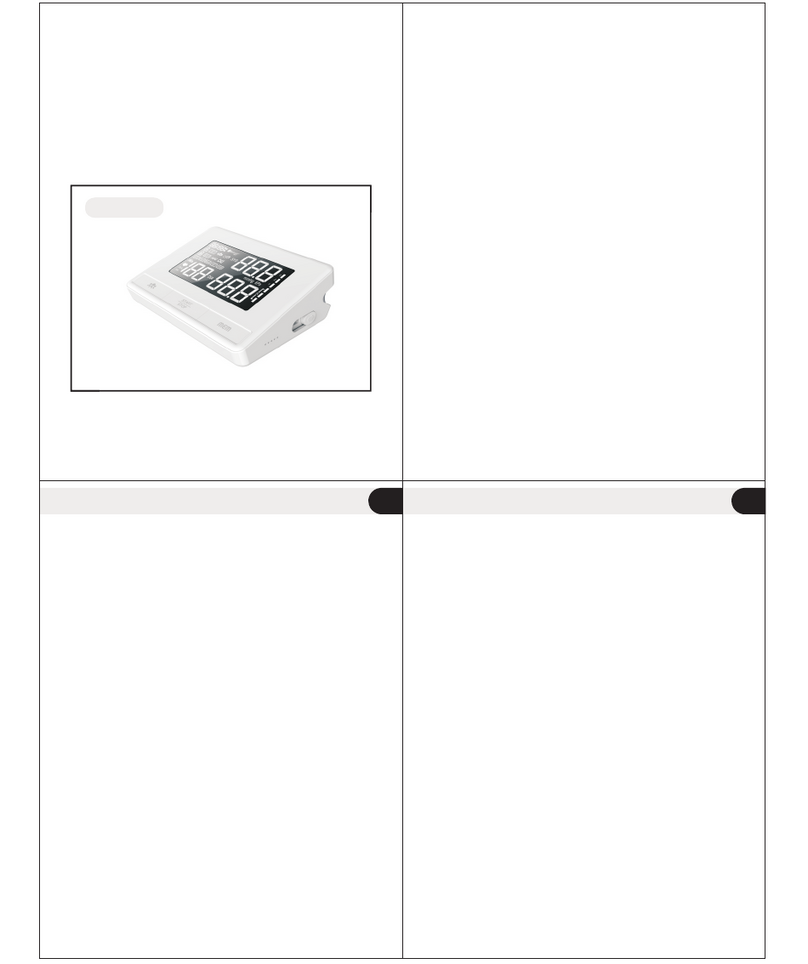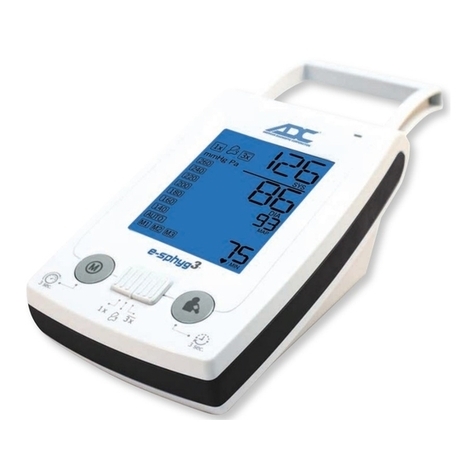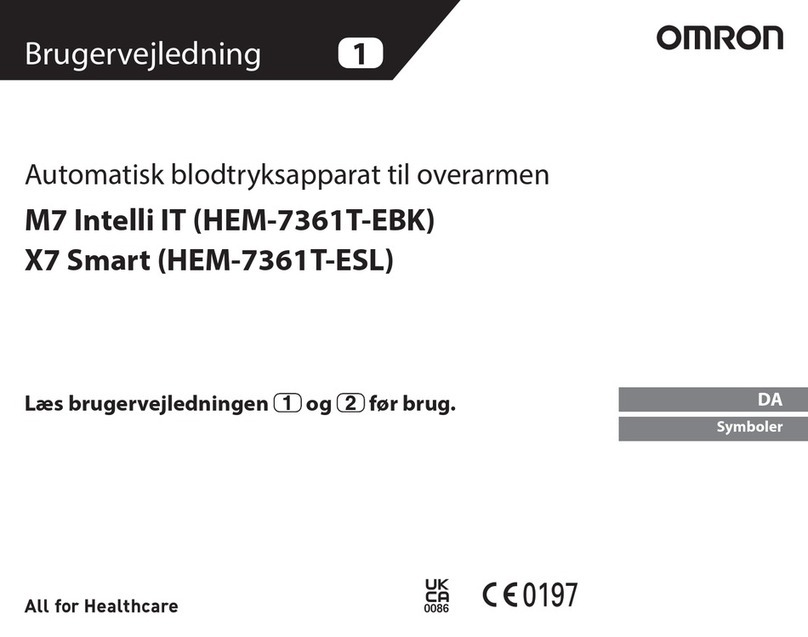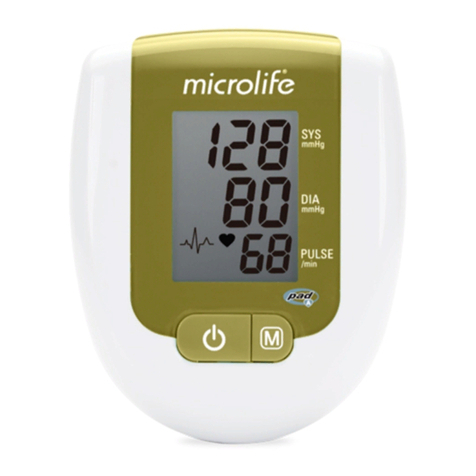Nissei WSK-1011 User manual

WSK-1011
INSTRUCTOIN MANUAL
DIGITAL BLOOD PRESSURE MONITORWSK-1011
INSTRUKCJA OBSŁUGI
CIŚNIENIOMIERZA CYFROWEGO WSK-1011
РЪКОВОДСТВО ЗА ЕКСПЛОАТАЦИЯ
НА ЦИФРОВ ТОНОМЕТЪР WSK-1011
UŽIVATELSKÝ NÁVOD
K DIGITÁLNÍMU TONOMETRU WSK-1011
A WSK-1011 TÍPUSÚ DIGITÁLIS TONOMÉTER
HASZNÁLATI UTASÍTÁSA
MANUAL DE UTILIZARE
A TENSIOMETRULUI DIGITAL WSK-1011
ROU HUN CZE BGR POL ENG

2
ENG
This manual contains information useful for safe and efficient operation of digital blood pressure monitor model WSK-1011 (hereinafter “De-
vice”). Do not use this device in any manner other than that specified in this manual. Please look thoroughly through this manual and particu-
larly“Recommendations for Correct Measurement”.
PARTS AND COMPONENTS
1. ELECTRONIC UNIT
2. BATTERIES
3. BAG
A.
SET BUTTON (SETTINGS)
B. BUTTON (MEMORY 1)
C. BUTTON (MEMORY 2)
D. START/STOP BUTTON (START/STOP)
E. LCD DISPLAY
F. CUFF
G. BATTERY COMPARTMENT

3
ENG
GENERAL INFORMATION
INDICATIONS FOR USE
The device is designed to measure systolic and diastolic blood pressure and heart rate reading in patients aged 13 years and older. This device should
not be used for neonate or infant. Consult your doctor for blood pressure measurement in children or person in pregnancy or under pre-eclamptic
condition. The device is recommended for use in patients with unstable (nonpermanent) blood pressure or hypertension at home as a supplement to
medical surveillance.
The cuff is suitable for a wrist with a circumference of about 12,5 - 22,5 cm.
Blood pressure is measured in the range from
50 to 250 mmHg for systolic and 40 to 180 mmHg for diastolic, in the range from 40 to 160 heartbeats per minute.
OPERATION PRINCIPLES
The device uses the oscillometric method of measurement. Connect a cuff to an electronic unit and wrap it around your wrist. When you press the
START/STOP button, the device starts the automatic inflation, which is followed by the blood pressure measurement. The sensor element of the
device detects slight pressure oscillations in the cuff produced by the expansion and contraction of the brachial artery in response to each heart-
beat. Rhythm and amplitude of the pressure waves are measured and displayed on the LC display as a numerical value in millimeters of mercury.
The device has an irregular pulse rhythm indicator, as well as two memories with 60 cells in each calculating the average value.
NISSEI New Technologies
Fuzzy Inflation Algorithm – is an algorithm for automatic selection of the cuff inflation pressure. Using this algorithm, the device by
itself determines the pressure level to which it is necessary to inflate the cuff based on the patient’s systolic pressure. Owing to the
Fuzzy Inflation algorithm the device becomes easier to use, while the measurement gets more comfortable and more accurate.
Irregular Pulse Rhythm indicator is a special icon on the display that informs on the irregular heartbeat, while the measurement
result is correct.
Touch control
–
is control of the device by slight touching it
.
Body motion indicator
–
indicator informs the occurrence of possible body motion that can affect the measurement result.
Pulse pressure
–
along with the measurement result the device displays the pulse pressure value. Pulse pressure is a difference
between systolic and diastolic pressure
.
M-Cuff series is a unique cuff unit designed and patented by NISSEI. M-shaped cuff can read pulse wave simultaneously from two
arteries.

4
ENG
COMPLETE SET
The complete set WSK-1011 includes:
- Electronic unit with cuff – 1 pc.
- Batteries – 2 pcs.
- Bag – 1 pc.
- Instruction Manual – 1 pc.
- Packaging – 1 pc.
RECOMMENDATIONS ON CORRECT MEASUREMENTS
1. If treated with hemodialysis or anticoagulants, antiplatelets or steroids, refer
to your doctor about the blood pressure measurement.
2. Malfunctions are possible when the device is used near working mobile
phones, microwave ovens and other equipment generating electromagnetic
radiation.
3. For correct measurement it is necessary to know that the BLOOD PRESSURE
IS SUBJECT TO SHARP FLUCTUATIONS EVEN IN SHORT TIME INTERVALS. The
blood pressure level depends on many factors. It is commonly lower in summer
and higher in winter. Blood pressure varies along with atmospheric pressure
and depends on the physical exertion, emotional excitability, stress and diet.
Medical drugs, alcohol and smoking exert great influence as well. Occasionally,
measurements in the clinic cause an increase in pressure values. Therefore,
blood pressure measured at home is often different from that measured in the clinic. Since blood pressure increases at low temperatures,
measurements should be made at room temperature (about 20°C). In case the product is stored in the environment with ambient temperature
above 40˚C or below 10˚C, please leave it for at least 2 hours before taking a measurement. During the day, the difference in the readings in
healthy people may attain 30-50 mm Hg for systolic (upper) pressure and up to 10 mm Hg for diastolic (lower) pressure. Dependence of blood
pressure on various factors is individual for each person. Therefore it is recommended to keep a special recording of blood pressure readings.
ONLY A DOCTOR MAY ANALYZE TRENDS IN CHANGING YOUR BLOOD PRESSURE BASED ON CORRESPONDING RECORDINGS.
Fig.1
Blood pressure variations during a day
Systolic
Diastolic
Arterial pressure (mmHg)
Time of day

5
ENG
4. In case of cardiovascular diseases and a number of other diseases that require the blood pressure monitoring, measurements should be
carried out in the hours specified by a doctor. REMEMBER THAT THE DIAGNOSTICS AND ANY TREATMENT OF ARTERIAL HYPERTENSION SHOULD
BE CARRIED OUT ONLY BY A DOCTOR BASED ON BLOOD PRESSURE READINGS OBTAINED BY A DOCTOR. MEDICAL DRUG ADMINISTRATION OR
CHANGE OF DOSAGES SHOULD BE MADE ONLY BY PRESCRIPTION OF AN ATTENDING DOCTOR.
5. In case of disorders such as deep vascular sclerosis, weak pulse wave and break in rhythm of heart contractions, the correct blood pressure
measurement can be complicated. IN THIS CASE, A DOCTOR SHALL PROVIDE RECOMMENDATIONS IN RELATION TO USE OF THIS DEVICE.
6. KEEP QUIET DURING THE MEASUREMENT TO OBTAIN THE CORRECT BLOOD PRESSURE READING WHEN USING THE ELECTRONIC DEVICE. The
blood pressure measurement should be carried out in a quiet comfortable atmosphere at room temperature. Exclude meal an hour before the
measurement, and exclude smoking, soft drinks, and alcohol 1.5-2 hours before the measurement.
7. Accuracy of the blood pressure measurement depends on matching the device cuff and size of your wrist. THE CUFF SHOULD NOT BE
TOO SMALL OR TOO BIG.
8. Repeated measurements are carried out at 5-minute intervals to recover the blood circulation. However, persons suffering from severe
atherosclerosis, due to a significant loss of elasticity of blood vessels, need longer intervals between measurements (10-15 minutes). This also
concerns patients suffering from long-term diabetes. For more accurate determination of blood pressure it is recommended to carry out a series of
three consecutive measurements and to calculate the average value of measurement results.
9. Do not use this device in an explosive environment such as near flammable anesthetics or inside oxygen chamber.
10. The system may fail to yield specified measurement accuracy if operated or stored in temperature or humidity conditions outside the limits
stated in the specifications section of this manual.
11. Do not use cuffs or accessories other than those specified by the manufacturer. Otherwise, correct measurement readings cannot be obtained.
12 Do not apply the cuff over wounded wrist, wrist of which side is under an intravascular access or therapy or an arterio-venous shunt, or wrist on
the side of a mastectomy or lymph node clearance. Otherwise injury may be resulted.
13. Make sure that inflation of the cuff is not causing prolonged impairment of blood circulation. Also, be cautious about temporary loss of the
functions of any other medical equipment if any monitoring equipment is used on the same limb with the blood pressure measuring cuff.
14. Do not inflate the cuff when it is not wrapped around your wrist.
15. Do not apply the cuff on the limb which the intravenous drip infusion is implemented.

6
ENG
POWER SUPPLY OF THE DEVICE
Fig.2 Fig.3
1. Disconnect the battery compartment (Fig.2).
2.
Install two “AA” batteries in the compartment.
Make sure that polarity corresponds to signs (+) and (-) shown inside the
compartment (Fig. 3).
Batteries are readily installed by pressing the end“-“ on the spring.
3. Close the battery compartment.
Do not use excessive force when removing the cover.
Battery Replacement Indicator
Replace all the batteries when the battery replacement indicator is flashing on the display during the measurement. If upon the
device turning on the indicator is steadily flashing, the measurement will not be possible until all the batteries are replaced. The battery
replacement indicator does not show a discharge degree.
Use alkaline batteries to increase the device operation duration. Ordinary zinc-carbon batteries require more frequent replacement. The enclosed
batteries are meant for testing the sold device, and their operation period can be less than that of batteries acquired in the trade network.
Since neither the device nor the batteries are the waste that can be utilized at home, follow your national/local regulations for waste recy-
cling and take them to corresponding collection facilities
SETTING DATE AND TIME
Date and time can be set after installing batteries. Setting the date and time guarantees the preservation of measurement results with indicated
correct date and time. The device can be used without setting the date and time.
Press and hold the SET button until the display flashes the value of the year. Date and time are set in the following order: year, month, day, hour and
minute.

7
ENG
1. Setting the Year
Use the
button to increase and
button to decrease the year value. Press the SET button to confirm and to pass to the next step
.
2. Setting the Month
Use the
button to increase and
button to decrease the month value. Press the SET button to confirm and to pass to the next step
.
3. Setting the Day
Use the
button to increase and
button to decrease the day value. Press the SET button to confirm and to pass to the next step
.
4. Setting the Time
Watch uses a 12-hour time format of day. Use the button to increase and button to decrease the hour or minute value. Press the SET but-
ton to confirm the settings. To stop the setting, press the «START/STOP» button.
IMPORTANT! If the date and time are set, then when turned off the device display will show the current time.
CUFF PREPARATION
1. Holding your left arm with the palm facing up place a cuff on a wrist so that the meter display is on the palm side. Should
you fail to put the cuff on your left wrist, place it on the right one
2. Place the cuff on your wrist so that its edge is spaced by 5-10 mm off the palm end. Place the meter on the center of your
wrist (Fig.4).
3. Snugly wrap the cuff on your wrist without leaving any space between the cuff and the wrist. Make sure that the cuff
comfortably fits your wrist.
Put the cuff on a bare wrist only. Be careful to prevent your cloth being caught by the cuff.
CORRECT POSITION DURING MEASUREMENT
Measurement in the sitting position
1. Sit down on a chair that you can be comfortably seated with your legs uncrossed, feet flat
on the floor and back supported. Your forearm should also be supported on the table.
2. Lightly raise your left hand with the palm facing up and put your elbow on the table.
3. Bring the cuff to the heart level placing your arm on a case or folded towel (Fig.5).
5~10mm
Fig.4
Fig.5 Fig.6 Fig.7

8
ENG
In case of unavailability of a table
1. Sit down on a chair. that you can be comfortably seated with your legs uncrossed, feet flat on the floor and back supported.
2. Bring the cuff to the heart level lightly pressing your left hand to the chest (Fig.6).
3. While measuring lightly support your left arm by the right hand.
Measurement in the lying position
1. Lie on your back.
2. Bring the cuff to the heart level using a case and folded towel (Fig.7).
Try to use the same wrist and position for measurement.
If the cuff is positioned above/below the heart, resulting reading may be incorrect (lower/higher).
MEASUREMENT PROCEDURE
IMPORTANT! The device has touch-sensitive buttons that are pressed by slight touching. Moisture, dirt and extraneous
objects between the finger and the device panel can affect the ability of buttons to respond to touching.
Before measurement, take a few breaths and relax. During the measurement, do not talk and do not move.
1.
Press the START/STOP button. The deflating symbol
« »
will flash on the display, and the device will release the remaining air
from the cuff
(Fig.8).
2. Beep will be heard, and air will be pumped into the cuff. The symbol « » will flash, and the displayed value will increase (Fig.9).
Inflation will stop at optimum level owing to the Fuzzy Inflation algorithm.
3. The symbol « » will disappear and measurement will start up. The pressure cuff will slowly deflate.
Body Motion Indication
Blood pressure value taken while moving cannot be said to be the correct value because body move-
ment can affect blood pressure. This product analyzes pulse wave and displays
« »
when body motion is detected.
« »
indicates the results might be affected by body movement.
Press the START/STOP button to stop forcedly the measurement: the device will stop inflation and quickly release the air
.
4. Symbol
«
»
will start flashing simultaneously with the beep immediately after the pulse rate is detected
(Fig.10)
.
Fig.8
Fig.9
Fig.10

9
ENG
5. When the measurement is completed, the display will show the values of blood pressure, pulse
pressure, WHO scale and heart rate
(Fig.11).
The device will automatically release the air from the cuff.
6.
Press the
button or
button and the result will remain in the selected memory unit
.
7. Press the START/STOP button to turn off the device.
If you forget to turn off the device, it will do so automatically after 3 minutes.
Do not perform several measurements in a row.
This will cause numbing the arm and can affect the measurement result. Give your wrist a break for
at least 5 minutes.
INDICATION OF IRREGULAR PULSE RHYTHM
The flashing symbol « », appeared on the display reports on an irregular heartbeat rhythm
(Fig.12). If this symbol appears from time to time, refer to your doctor. The irregular pulse rhythm
indicator occurrence can be also caused by body movements in the course of the measurement.
INDICATION OF READINGS BY THE WHO SCALE
In addition to pressure numerical values, the result is also displayed as a graphic scale. This scale makes it
possible to classify the obtained blood pressure value in accordance with the World Health Organization
recommendations. The scale appears along with the numerical value of blood pressure in the lower right
corner of the display
(Fig.13)
.
Pulse, stroke/min.
Systolic pressure,
mmHg
Diastolic pressure,
mmHg
Puls pressure,
mmHg
Fig.11
Normal pulse
Pulse with arrhythmia
Fig.12
WHO indicator
Fig.13

10
ENG
Table of Results by the WHO Scale
Indication WHO Classication SYS DIA
Hypertension (severe) >180 >110
Hypertension (moderate) 160-179 100-109
Hypertension (slight) 140-159 90-99
Increased normal pressure 130-139 85-89
Normal pressure 120-129 80-84
Optimal <120 <80
Indication of Pulse Pressure
This device calculates and displays the pulse pressure value (Fig. 14). Pulse pressure – a difference be-
tween the systolic and diastolic pressures – tends to increase with aging.
Systolic blood pressure continues to increase with aging, while diastolic blood pressure tends to decrease
since the age of about 50 years.
It is considered that a high pulse pressure is related to poor elasticity of arteries and is one of the risk
factors for circulatory diseases. Pulse pressure is considered to be normal when it attains 35±10 mm Hg.
MEMORY FUNCTOIN
The measured values are automatically saved for later viewing in the selected memory unit. These memory units can be used to save
separately the measurement results of two different persons or to save separately the results of morning and evening measurements
.
Each unit can keep up to 60 measurement results and the average value thereof. When the number of kept values exceeds 60, the oldest
readings are deleted to record new values
.
Saved values are kept with the measurement date and time, if set. If you want to save time and date together with the measurement values,
Pulse pressure
mmHg
Fig.14

11
ENG
date and time should be set before the measurement
.
When an error occurs (ERR), the measurement results are not saved
.
Viewing the Saved Data
1.
Turn off the device by pressing the START/STOP button. To view the results stored in the memory unit 1, press , and to view the results
stored in the memory unit 2, press . The selected memory unit will be underlined on the display.
The display shows the average value of stored results indicated with index « » (Fig.15). Average value is
displayed when the selected memory unit contains two or more saved measurement results.
2.
Each time you press the
button or
button, saved measurement results will be displayed in a
sequential manner
.
3.
Memory unit number, measurement date and time will be displayed one by one in the upper right
corner of the display
.
4.
The result saved in the memory unit 1 is the most recent among the saved data in the selected memory.
The higher memory number, the older the result.
The memory data are displayed for about 30 seconds and after that, if no button is pressed, the device is
automatically turned off
.
Pressing the
button switches the display from records in the memory unit 1 to records in the memory
unit 2, while pressing the
button results in returning to data recorded in the memory unit 1
.
5.
Press the START/STOP button to turn off the device
.
Deletion of Saved Data
Readings can be deleted unit by unit: all together or separately. The memory may be cleared when the selected memory unit contains two
or more results.
1 . Select a value from the memory unit to be deleted or the average value (unit with index
« »)
to clear the whole memory unit
.
2 .
Press and hold the
button or
until the sign «---» appears on the display
.
INFORMATION ABOUT ERRORS
INDICATION LIKELY CAUSE METHODS OF CORRECTION
Blood pressure is too
low or too high. The cuff is not at the heart level.
The cuff is put on incorrectly.
During the measurement, a person was talking or moving.
Put on the cuff at the heart level.
Check the cuff position on the wrist.
Be calm and quiet during the measurement.
Selected memory
indicator Average
value
index
Number of saved measurements
Fig.15

12
ENG
Measurement results are
different each time.
Effect of measurement conditions, physical or mental state. Take measurements under the same conditions.
Measurement results are
different in clinic and
at home.
Effect of relaxed state at home and tension in clinic. Show the pressure records made at home to your doctor for advice.
Inflation is repeated. If the initial pressure is insufficient, inflate the cuff again. Inflate the
cuff till your pressure will be successfully measured. Re-inflation is not a malfunction of the device. Do not talk and do not
move during the measurement.
Maximum allowable pressure: pressure can not be measured due to
movement or talking during the measurement, in spite of the fact that
the cuff was pumped at maximum.
Do not talk and do not move during the measurement.
or
Pressure can not be measured due to movement or talking. Do not talk and do not move during the measurement.
Cuff is not securely connected to the device.
Cuff is not put on properly. Check the connection.
Make sure that the cuff is put on correctly.
Batteries are discharged. Replace all batteries with new ones.
No time indication on
the display.
Time was not set.
Note: there is no time indication when batteries and/or power source
are not provided.
Set time and date.
Install batteries and connect the power source.
Date and time are
displayed as «--/--». Time was not set or measurements were carried out before setting
the time. Set date and time.
Date and time can not be saved without setting.

13
ENG
Nothing is shown on
the display. Batteries are discharged.
Batteries are installed incorrectly.
Connecting terminals are contaminated.
Power source is not connected.
Replace all batteries with new ones.
Install batteries properly.
Wipe connecting terminals with a dry cloth.
Connect the power source.
You touched the START/STOP button when installing the batteries. Turn off the device by pressing the START/STOP button and perform
the measurement again.
If, despite the above-given recommendations, you fail to obtain the right measurements, stop the operation and contact the service center (addresses and
telephone numbers of authorized organizations are provided in the warranty certificate). Do not attempt to adjust the device internal mechanism on your own
.
WARRANTY
1.
The manufacturer guarantees the warranty period of 5 years for the device from the sale date provided that the consumer observes
operation, transportation and storage requirements. The warranty period for the cuff and the power source is 12 months from the sale date.
2. Warranty liabilities are documented with the warranty certificate upon selling the device to the buyer. The guarantee is valid provided
that the device has not been opened or damaged by the buyer.
3. Addresses of organizations engaged in the warranty service are specified in the warranty certificate.
TECHNICAL SPECIFICATIONS
Operating Principle Oscillometric method
Indicator 15 digits liquid crystal display
Indicating Range
:
cuff pressure, mmHg
0-300
Measuring Range :
cuff pressure, mmHg
pulse rate, bpm
50-250 (systolic), 40-180 (diastolic)
40 - 160

14
ENG
Accuracy:
cuff pressure, mmHg
pulse rate, %
±3
±5
Inflation Automatic inflation (air pump, Fuzzy Inflation algorithm)
Deflation Automatic Deflation (electric valve)
Electric supply voltage, V 6
Electric supply type Two 1.5 volt LR6 (AA alkaline) batteries
Memory 2 units, 60 values per each + average value
Operating Condition
temperature, ˚C
humidity, % Rh +10 to +40
15 to 85
Storage Condition
temperature, ˚C
humidity, % Rh
-20 to +60
10 to 95
Cuff Size adult
(
circumference of the wrist
12,5-22,5 cm)
Overall dimensions:
Size (electronic unit), mm
Weight (without packaging, bags and batteries), g
70 x 70 x 27
110
Manufacture year: specified on the device housing (in the battery compartment) in the device serial number
after the letters «SN»
Protection level
IP 20: Protected against solid foreign particles with a diameter of more than 12.5 mm, no
protection against water.
Protection against electric shock:
Internally powered equipment, Type BF applied part
Mode of operation: Continuous operation
Classification: Internally Powered Equipment
Expected Service Life: 5 years

15
ENG
Key to Symbols
Type BF applied part
Refer to instruction manual/booklet
Keep dry
When utilizing the waste, refer to current rules applicable in your region
*This device complies with EN1060-1:1995+A2:2009 Non-invasive sphygmomanometers Part 1: General requirements and EN1060-3:1997+A2:2009 Non-
invasive sphygmomanometers Part 3: Supplementary requirements for electro-mechanical blood pressure measuring system
*Accuracy is guaranteed with the measured values that are within the measuring range.
*The measurement accuracy of the device has been proven according to ISO 81060-2 protocol. In the clinical study, K5 was used for the determination of
diastolic pressure values at all auscultatory measurements.
*This device is intended for use in the environment with one atmospheric pressure.
*Specifications are subject to change without notice due to improvements in performance.
Revision date of the present Manual is indicated on the last page as EXXX/YYMM/XX, where YY is the year and MM is the month of revision.
CARE, STORAGE, REPAIR AND DISPOSAL
1. Because the product includes precision parts, avoid extreme temperature variations, humidity, shock, dust, lint, and direct sunlight. Do not
drop or strike the product. Make sure not to expose it to moisture. This product is not water resistant.
2. Do not keep or do not use the device in close proximity to heaters and open flame.
3. In case the product is stored in the environment with ambient temperature above 40˚C or below 10˚C, please leave it for at least 2 hours
before taking a measurement.
4. If the device has not been used for a long time, remove the batteries. Leaking of batteries can cause damage to the device and terminate
the warranty. KEEP BATTERIES AWAY FROM CHILDREN!
5. Do not contaminate the device and protect it from dust. The device can be cleaned with a dry, soft cloth.
6. Do not allow the contact between the device and its parts with water, solvents, alcohol, and gasoline.
7. Keep the cuff away from sharp objects, and do not try to pull out the cuff.
8. Do not expose the device to strong strokes and do not throw it.
9. The device does not contain any adjustment controls for settings. Unauthorized opening of the electronic device is forbidden. If needed,
repair the device only in specialized organizations.
10.
On the expiry of the specified operation term, refer to specialists (specialized repair organizations) on a periodic basis to check the technical
condition of the device.

16
ENG
11.When utilizing the waste, refer to current rules applicable in your region. No special utilization conditions are specified by the manufacturer
for this device.
12. Keep the product clean. Inspect its cleanliness after use. To clean, use only a soft dry cloth. Do not use gasoline, paint thinner, or other
strong solvents. Since the cuff may absorb perspiration and other fluids, inspect it for stain and discoloration after each use. The cuff is
resistant to repeated sanitation. The cuff internal fabric surface (being in contact with a patient’ wrist) can be treated with a cotton swab
moistened in a 3% solution of hydrogen peroxide. Partial discoloration of the cuff covering tissue is possible if used for a long time.
13. Stop using the device immediately and contact your dealer or the manufacturer in case any visible damage is found on the device.
14. Do not press the display or place the device with display face down.
15. The device contains small parts and batteries which could be swallowed by children or pets. They should therefore be kept out of the reach
of children and pets at all times.
16. This device is not designed for self-use by unspecified persons in public areas.
17. Any serious incident occurred in relation to the device should be reported to the manufacturer and the competent authority in your coun-
try/area. If you have no contact information of such authority, please contact the manufacturer or EU authorized representative whose con-
tact information is indicated in this instruction manual.
CERTIFICATION AND STATE REGISTRATION
The production of devices is certified pursuant to international standards such as ISO 9001, ISO 13485, ISO 14001.
The device meets international standards IEC 60601-1:2005+A1:2012 and IEC 60601-1-2:2014.
Complaints and requests should be addressed to:
Little Doctor Europe Sp. z o.o.
57G Zawila Street, 30-390, Krakow, Poland
Tel.: +48 (12) 268-47-46, (12) 268-47-47. Fax: +48 (12) 268-47-53
E-mail: biuro@littledoctor.pl
Produced by Nihon Seimitsu Sokki Co., Ltd.
Manufacturer: NIHON SEIMITSU SOKKI CO., LTD.
2508-13 Nakago Shibukawa Gunma 377-0293 Japan
web site www.nissei.pl

TECHNICAL DESCRIPTION
WSK-1011 complies with the Electromagnetic Disturbances standard, IEC60601-1-2:2014.
As a medical electrical equipment, special precautions regarding the electromagnetic disturbances shall be taken at usage of the
device according to the information provided below.
• The device is not intended for use in environments where the intensity of electromagnetic disturbance is high, such as near active HF
surgical equipment and MRI (magnetic resonance imaging) equipment etc.
• Use of the device adjacent to or stacked with other equipment must be avoided because it could result in improper operation.
• Use of accessories other than those specified or provided by the manufacturer could result in increased electromagnetic emissions
or decreased electromagnetic immunity of the device and result in improper operation.
• Portable RF communications equipment (including peripherals such as antenna cables and external antennas) should be used at
least 30cm away from any part of the device, including specified cables. Otherwise, degradation of the performance of this equipment
could result.
Please contact your dealer or the manufacturer for specific information regarding the compliance to the standard.

NIHON SEIMITSU SOKKI CO., LTD.
2508-13 Nakago Shibukawa Gunma 377-0293 Japan
E468/1902/04
MDSS GmbH
Schiffgraben 41, 30175 Hannover, Germany
Website: www.nissei.pl
®Registered trademark.
©
Copyright 2019.
Other manuals for WSK-1011
2
Table of contents
Other Nissei Blood Pressure Monitor manuals
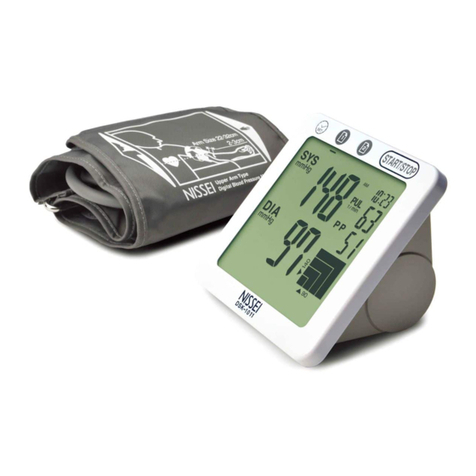
Nissei
Nissei DSK-1011 User manual
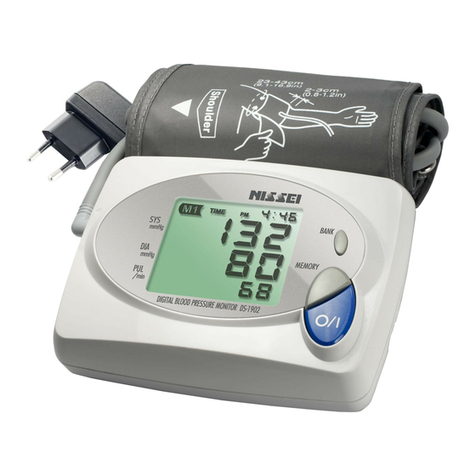
Nissei
Nissei ds-1902 User manual
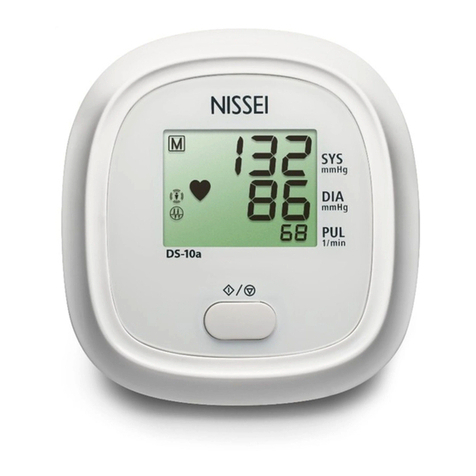
Nissei
Nissei DS-10a User manual

Nissei
Nissei DS-137 User manual
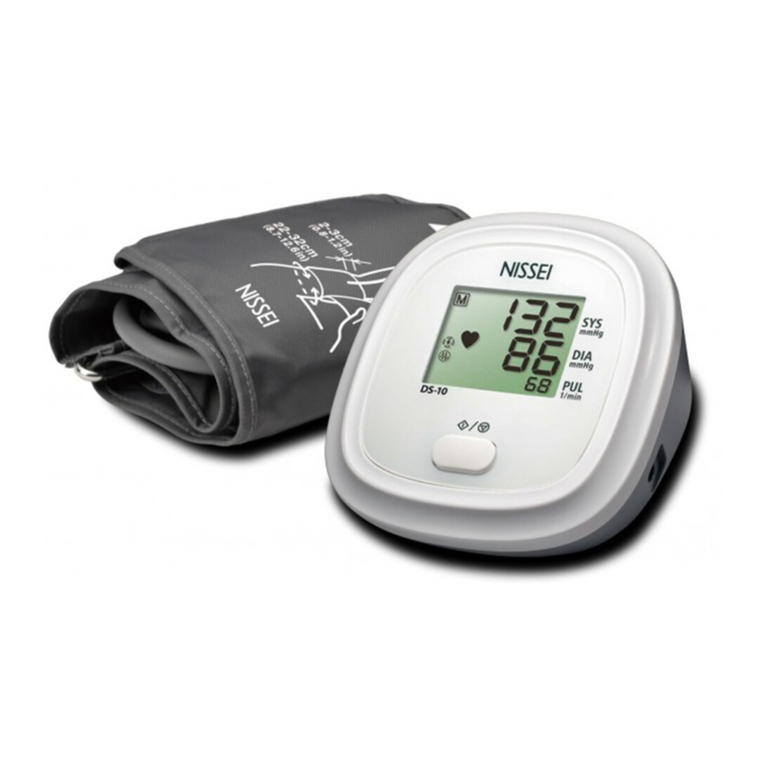
Nissei
Nissei DS-10 User manual

Nissei
Nissei WS-820 User manual

Nissei
Nissei DSK-1031 User manual

Nissei
Nissei WS-820 User manual
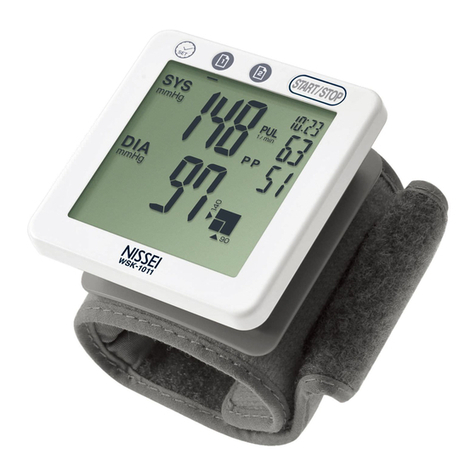
Nissei
Nissei WSK-1011 User manual
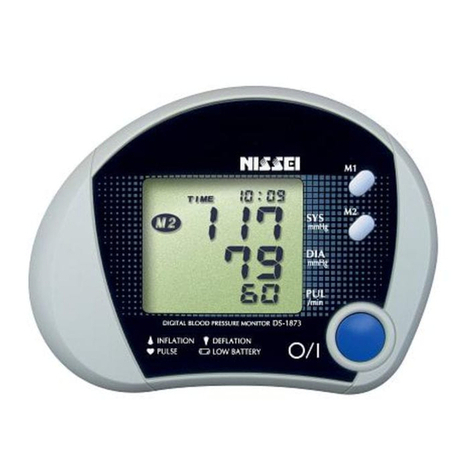
Nissei
Nissei DS-1873 User manual
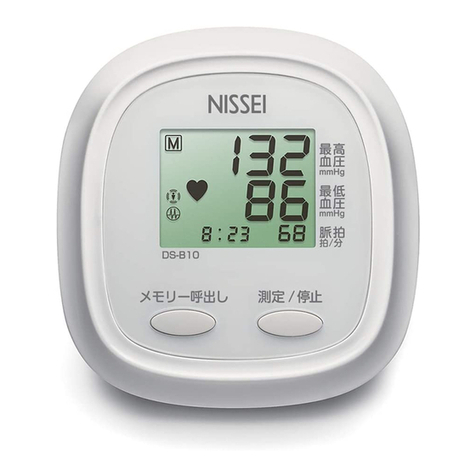
Nissei
Nissei DS-B10 User manual

Nissei
Nissei DS-400 User manual
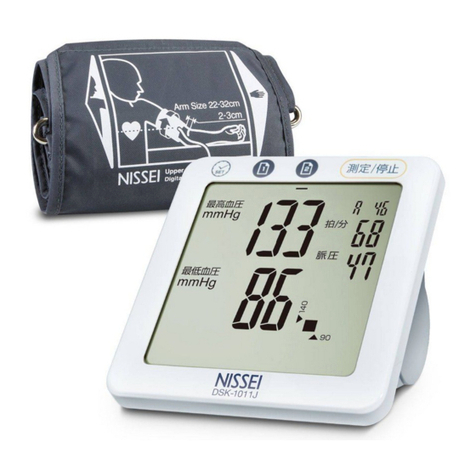
Nissei
Nissei DSK-1011J User manual

Nissei
Nissei DS-10 User manual

Nissei
Nissei WS-1300 User manual
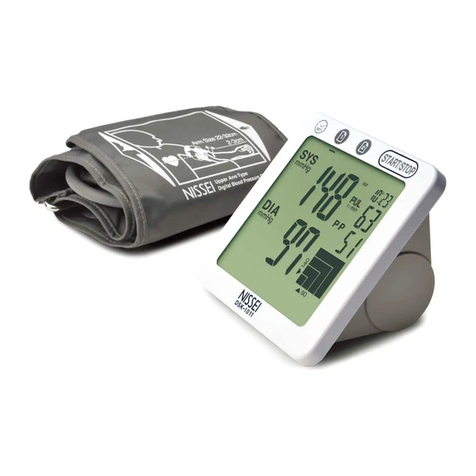
Nissei
Nissei DS-1011 User manual

Nissei
Nissei DS-S10 User manual

Nissei
Nissei DSK-1031 User manual

Nissei
Nissei WSK-1011 User manual
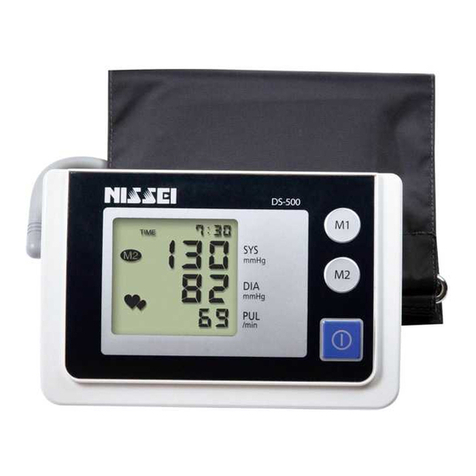
Nissei
Nissei DS-500 User manual



